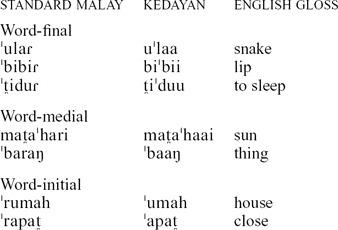In Malaysia, Kedayan (ISO code ‘kxd’) speakers are found primarily in the state of Sabah, the state of Sarawak, and the federal territory of Labuan, which is an offshore island near Sabah. Lewis (Reference Lewis2009) classifies Kedayan as one of the many Malayic dialects within the Malayo-Polynesian branch of Austronesian languages.
I was unable to reach the current President of the Kedayan Cultural Association in Sabah, Malaysia, for a population estimate of Kedayan speakers in Malaysia. But on 19 July 2013, I was able to reach the former President of the Kedayan Cultural Association in Sabah, Malaysia, Mr Haji Osman. Mr Osman states that there are about 30,000 speakers of Kedayan in Sabah, 30,000 speakers in Sarawak, 15,000 in Labuan, 600 in West Malaysia and between 100,000 and 200,000 speakers in the country of Brunei. In fact, Mr Osman states that as much as 60% of the population of Brunei could be Kedayan speakers. Kedayan is sometimes spelled as ‘Kadayan’, ‘Kedaian’, and ‘Kadyan’.
According to an unpublished lexicostatistic survey done by the present author, Kedayan is between 83–89% lexically similar to Brunei Malay, but only 75–81% lexically similar to Standard Malay (as spoken in Malaysia). This language survey was conducted from 1998 to 2000 and was sponsored by the State Culture Board of Sabah, Malaysia. Another important difference is that the /r/ sound does not occur in Kedayan but does occur in Brunei Malay.
Previous research on Kedayan includes a published wordlist of Kedayan bird names (Maxwell Reference Maxwell1969) as well as Moody's (Reference Moody1984) lexicostatistic comparisons of Kedayan with other Malayic languages. In 1984, Moody stated that the population of Kedayan speakers in Sabah, Malaysia, was only 11,500. Moody also stated that the dialect intelligibility testing among four Brunei and Kedayan villages confirms Smith's (Reference Smith1984) lexicostatistic analysis which classified these languages as representatives of a single language. Moody stated that lexical similarity between Kedayan and Brunei Malay ranged from 77% to 93% and that Kedayan was 60–80% lexically similar to Standard Malay, as spoken in Sabah, Malaysia. Moody noted, however, that there is no complete mutual intelligibility among speakers of these languages.
The ‘North Wind and the Sun’ text was translated and read by Mr Abdul Kadir Hassan, age 55 at the time of the recording. Mr Hassan was born in Sipitang, Sabah, Malaysia. He speaks both Kedayan and Sabahan Malay fluently.
Consonants
The voiceless plosives /p
![]() k/ are unaspirated, and unreleased in syllable-final position. The plosive /b/ can occur word-initially, word-medially, and word-finally. But it seems that the plosives /d/ and /g/ do not occur word-finally.
k/ are unaspirated, and unreleased in syllable-final position. The plosive /b/ can occur word-initially, word-medially, and word-finally. But it seems that the plosives /d/ and /g/ do not occur word-finally.
The bilabial approximant, [w], never occurs word-initially.
The palatal nasal, [ɲ], occurs word-initially in [ˈɲasah] ‘to wash’ and word-medially in [maˈŋaɲam] ‘to weave’. But we have no cases of the palatal nasal occurring in the word-final position. Audio is not available for these examples.
The glottal fricative, [h], occurs in all environments even though in some other Malayic languages it does not occur in all environments (Soderberg Reference Soderberɡ2014).
The glottal stop, [ʔ], occurs as an allophone of /k/ word-finally, e.g. [ˈlauk] ~ [ˈlauʔ] ‘side dish’, and [ˈsiɾak] ~ [ˈsiɾaʔ] ‘salt’. Audio is not available for these examples.
The alveolar flap, [ɾ], is not part of the inventory of indigenous Kedayan phones. It does occasionally occur in Kedayan speech but this is due to the influence of Malay, the national language. When a Kedayan word is pronounced and that word is cognate with a Malay word containing word-final [ɾ], the Kedayan vowel before the deleted [ɾ] will lengthen as the examples indicate in the first part of the following:
/r/-deletion in Kedayan
This finding is consistent with Poedjosoedarmo (Reference Poedjosoedarmo, Martin, Ozog and Poedjosoedarmo1996: 41) and Clynes (Reference Clynes2001: 12). This lengthening rule does not apply when the deleted [ɾ] occurs in word-medial and word-initial environments.
Vowels
Unlike Indonesian and Standard Malay, which have six vowel phonemes, /i e ə a o u/ (Soderberɡ & Olson Reference Soderberɡ and Olson2008, Clynes & Deterdinɡ Reference Clynes and Deterdinɡ2011), Kedayan is similar to Brunei Malay in that both of these languages have only three vowel phonemes, /i a u/ (Clynes Reference Clynes2001).
Due to the influence of Malay, the national language, one can occasionally hear the mid back vowel, [o] in Kedayan. Normally, however, in Kedayan this sound is realized as the high back vowel, [u], as we can see in the following examples:
Kedayan back vowel
The schwa, [ə], of Standard Malay is generally realized in Kedayan as the low central vowel, [a].
Kedayan low central vowel
The mid front vowel, [e], which occurs in Malay, is normally realized as [i] in Kedayan:
Kedayan high front vowel
Stress
Stress in Kedayan is predictable. Unaffixed words in isolation take primary stress on the penultimate syllable, e.g. [duˈii] ‘thorn’, [ˈaŋin] ‘wind’, [aˈkaa] ‘root’.
Transcription and glosses of recorded passage
In each segment, free translation follows the gloss. Abbreviations used in glosses:
emp = emphasis; int = particle marking what is being questioned in an interrogative sentence; nom = nominalizer; pass = passive.
-
1.

-
2.

-
3.

-
4.

-
5.

-
6.

-
7.

-
8.

-
9.

-
10.

-
11.

-
12.

Acknowledgements
I wish to thank Margaret Hartzler, Haji Osman and two anonymous reviewers with the Journal of the International Phonetic Association for their helpful comments and suggestions. All errors are my responsibility.
























